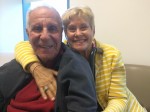James Manzi was supposed to have an evening of celebration.
He was out to dinner with family and friends for their daughter’s birthday, when his wife turned around and saw him slumped over and unconscious in his chair. It would take fast thinking and an unusual procedure to save his life.
After an ambulance brought him to the Ronald Reagan UCLA Medical Center emergency room, doctors shocked Manzi’s heart 29 time with a defibrillator in an attempt resuscitate him from what was a full cardiac arrest.
But the attempts were unsuccessful. The doctors had to think of a backup plan, and time was running out.
The medical team decided to try an unconventional procedure for heart attack patients: extracorporeal membrane oxygenation, a machine that essentially oxygenates the blood outside of the body and pumps it back in, taking over the functions of the heart and allowing it to rest.
Manzi responded to the procedure well enough for doctors to surgically unblock the arteries in his heart – and save his life.
Manzi’s case is unusual because he was the first person who had survived the procedure and make a full recovery, said William Suh, his cardiologist who performed the procedure and subsequent heart surgery.
Manzi’s success might give more doctors the confidence to attempt the unconventional procedure on other heart attack patients to save more lives, Suh said.
Manzi, who celebrated his 80th birthday on Sunday, said he is grateful that his doctors were so persistent in their efforts.
“I think if I happened to be admitted to any other hospital that night, I’d be in a box right now,” Manzi said.
Manzi woke up about five weeks after the incident in the intensive care unit, with some slight neurological damage because of a lack of oxygen to his brain. He soon began therapy at the UCLA Neurological Rehab Unit and has since returned to his normal health.
The procedure – normally used for transplant patients and premature babies – is unavailable in most hospitals because of its cost and the amount of training required to monitor it.
Tubes are inserted into the patient’s leg and groin area and threaded up to the heart.
Heart defibrillators, which are normally used to resuscitate heart attack victims, administer electric shocks to the patient’s heart in an attempt to restore normal rhythm.
Only one out of 10 patients who have heart attacks outside of a hospital survive, Suh said.
Dr. Eric Savitsky, the attending emergency room physician that night, made the decision to request that Manzi be considered for the procedure.
When the team attempted to resuscitate Manzi using the defibrillator, his heart would begin to beat normally after each shock, but the rhythm would deteriorate soon after.
He said he remembered reading about the potential uses for extracorporeal membrane oxygenation in a peer-reviewed journal and therefore thought Manzi had a chance of survival if the medical team was somehow able to keep the blood flowing in his body to stabilize it enough to perform heart surgery.
“The team was luckily able to make a very quick decision,” Savitsky said.
Extracorporeal membrane oxygenation is not normally used for heart attack patients because most hospitals do not have the capability to carry out the procedure, Savitsky said.
UCLA Medical Center performs complicated surgeries and transplants, so he was aware that they had this technology available, he added.
Oftentimes the brains of people who have suffered from heart attacks have been deprived of oxygen for prolonged periods of time, resulting in irreversible neurological damage, Suh said. Even if heart attack patients were given extracorporeal membrane oxygenation, there is a chance they would not be able to function normally afterward, he added.
Although Manzi does not remember anything between having the heart attack and waking up in the ICU more than a month later, he said he is grateful the doctors allowed their quick thinking to overcome.
Suh said the use of the procedure on future heart attack victims will probably be done on a case-by-case basis, but Manzi’s successful outcome might give doctors more of a reason to try it.
It was the first time Savitsky used the procedure in his 20 years in the UCLA emergency room, but he said he thinks it is a powerful tool that has the potential save more lives if used properly and on the right patients.
